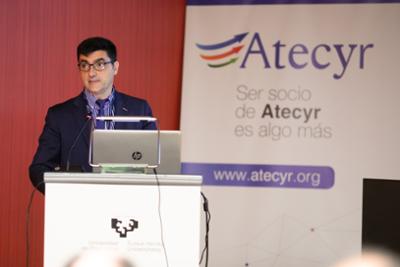

Pedro G. Vicente Quiles (ATECYR): "We need to be extremely watchful of regulatory alterations in 2024.”

Pedro G. Vicente Quiles, President of the Technical Committee of ATECYR (Spanish Technical Association of Air Conditioning and Refrigeration), explains in the following interview the major challenges facing the air conditioning and refrigeration sector , and outlines the measures being implemented to improve efficiency and sustainability.
What are the primary obstacles that air conditioning and refrigeration businesses will face in 2024?
In this context, I would pinpoint three main obstacles faced by the air conditioning and refrigeration industry today. Firstly, the need for professionals. We are an expanding industry and it's important to increase knowledge of the profession among young professionals. We need to explain why air conditioning and refrigeration are important in the global effort to reduce CO2 emissions and encourage upcoming professionals to join this industry, which focuses on energy efficiency, renewable energy and sustainability.
Secondly, the industry needs to create its own path and a well-organised and suitable plan, tailored to each case, for its operations to contribute to the sector's decarbonisation. This task is a worldwide legal obligation, meaning we are responsible for the environment on behalf of future generations. This requires adherence to the "energy efficiency first" principle, which is integrated into the Directive of the European Parliament and the Council on energy performance of buildings. This principal advocates for minimising energy consumption, resulting in greater savings in energy and raw materials. Following this, renewable energies may be employed.
And the third challenge is to remain vigilant to the regulatory alterations that we are expected to encounter in 2024. The Energy Performance of Buildings Directive and the F-gas Regulation, which prohibits the use of fluorinated greenhouse gases, will result in significant alterations to the planning, building, and upkeep of air conditioning and refrigeration systems in the future.
What steps is the sector already taking towards efficiency and sustainability?
Our industry has always been highly aware of energy efficiency. For many years, we have followed RITE's energy efficiency requirements, as well as the Ecodesign Regulations and energy consumption calculations for buildings, to comply with the Technical Code's requirements. Moreover, companies within the sector are not only specialising in solar thermal installations but also solar panels.
Another concern is sustainability, which has a broader scope as it requires the evaluation of the environmental impact of constructing and demolishing structures. In the future, we will need to assess technical solutions using life cycle analysis, a skill we must acquire.
The Energy Performance of Buildings Directive requires all buildings to be net-zero by 2050. This is a significant extra challenge that is currently not attended to well enough, as we prioritise decarbonisation. Decarbonising is crucial, but it cannot be overlooked that the term "zero emission buildings" presents difficulties that extend beyond decarbonisation.
Atecyr's measures aim to tackle the challenges outlined. These include generating documentation, sharing technological advancements, and maintaining training quality.
The Association is striving to spread current procedures and technologies that can aid in conquering the challenges faced during this industry transformation. An array of materials, including books, technical documents, reports, newsletters, articles, videos, etc., are produced. Furthermore, we provide technical support, offer media interviews, and arrange industry events and conferences to share expertise and best practices among sector professionals. We would like to thank the technicians and other staff for their work and commitment and encourage them to continue providing Atecyr with their expertise.
I would like to stress that Atecyr collaborates closely with the Administration at all levels, including regional, national, and European. In these relationships, the association offers maximum support within its capabilities and safeguards the interests of associated professionals, while upholding the founding values of commitment, trust, independence, integrity, impartiality and thoroughness in all actions taken.
What reflections can you provide on energy-efficient technologies concerning the aim of zero emissions, as per European and Spanish regulations?
I believe that aiming for the entire building stock to be zero-emission by 2050 will be a highly ambitious challenge for the industry. So, we have decarbonisation. It is assumed that 90% of decarbonisation will occur via the electrification of thermal installations in buildings, largely through heat pumps. However, it is important to conduct a thorough investigation into prospective energy sources such as biomass, biogas, and hydrogen. There is much discussion surrounding hydrogen, however, implementing this energy source within buildings may prove challenging.
Existing technologies enable the decarbonisation of facilities, which are typically installed in new buildings. Renovating existing buildings can be challenging due to limited space and the necessity for extensive renovations to reduce energy consumption caused by thermal loads.
On the other hand, the heat pump remains a developing technology, facing a significant obstacle regarding the usage of refrigerants. For instance, using heat pumps to produce Sanitary Hot Water in colder climates is still a challenge.
All buildings being zero-emission by 2050 implies the requirement for existing buildings to also achieve zero-emission standards by 2050. The Directive defines a "zero emission building" as a highly energy-efficient building that enhances the energy system via demand flexibility. The structure should require only a small remaining amount of energy, which must be entirely provided by renewable energies, mainly produced on-site or in the vicinity. The intention is that buildings with zero emissions will use minimal electricity from the grid. All electricity generation will be 100% renewable by 2050.
The definition of a zero-emission building includes the term "flexibility of installations," which has not yet been addressed. By 2050, all electricity should be renewable, and buildings must manage their energy demand to help operate the grid.
Returning to the major challenges in the sector I mentioned earlier, how do you manage the shortage of skilled workers?
Fundamentally, as I mentioned previously, we must provide a wealth of information and reach out to professionals. On the one hand, we are firmly dedicated to producing technical documentation, and sharing best practices within the sector. On the other hand, we are fully committed to training and motivating young professionals to develop an interest in the sector.
Closely linked to training are visibility and distribution. The Association is actively promoting the spread of cutting-edge techniques and technologies aimed at addressing challenges during this intricate phase. An array of materials, including books, technical documents, reports, newsletters, articles, videos, etc., are produced.
Additionally, Atecyr encourages professional networking and the development of mutually beneficial connections between members and diverse groups and institutions. It is crucial that future professionals share responsibility for designing systems that safeguard the environment in their strategy.




